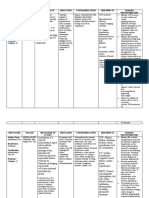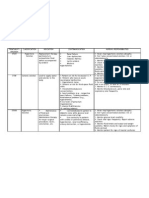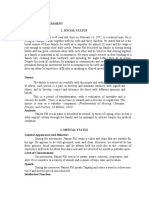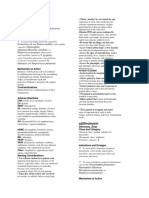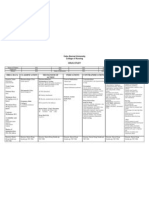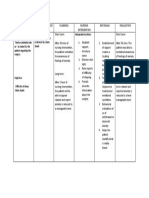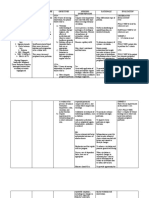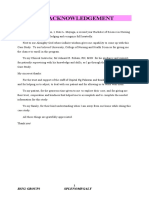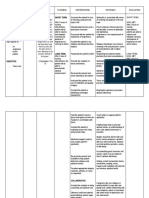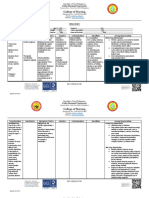0 ratings0% found this document useful (0 votes)
422 views"Nahadlok Naman Ko Sa Akong Gipambati, Ning-Undang Ko Sakong Work As QHSE and Training Manager, Nagdecide Ko Muuli Sa Pilipinas. Pag-Uli Nako Last Week, Ginabati Nako Mura Ko Makulbaan" As
"Nahadlok Naman Ko Sa Akong Gipambati, Ning-Undang Ko Sakong Work As QHSE and Training Manager, Nagdecide Ko Muuli Sa Pilipinas. Pag-Uli Nako Last Week, Ginabati Nako Mura Ko Makulbaan" As
Uploaded by
hanna caballo1. The patient, Pearly Shell, age 25, presented with symptoms of anxiety including hand tremors, fatigue, elevated blood pressure and heart rate, and nausea. Lab results showed hyperthyroidism.
2. The nursing diagnosis was anxiety related to a hypermetabolic state from hyperthyroidism. The goals were for the patient to have stable vital signs within normal range, appear relaxed, and identify healthy ways to deal with anxiety.
3. The nursing interventions included monitoring vital signs, observing behavior, speaking in brief statements using simple words, discussing anxiety and its causes, encouraging exercise, reinforcing coping, staying calm with the patient, and educating on anxiety symptoms. The evaluation was that within 2
Copyright:
© All Rights Reserved
Available Formats
Download as DOCX, PDF, TXT or read online from Scribd
"Nahadlok Naman Ko Sa Akong Gipambati, Ning-Undang Ko Sakong Work As QHSE and Training Manager, Nagdecide Ko Muuli Sa Pilipinas. Pag-Uli Nako Last Week, Ginabati Nako Mura Ko Makulbaan" As
"Nahadlok Naman Ko Sa Akong Gipambati, Ning-Undang Ko Sakong Work As QHSE and Training Manager, Nagdecide Ko Muuli Sa Pilipinas. Pag-Uli Nako Last Week, Ginabati Nako Mura Ko Makulbaan" As
Uploaded by
hanna caballo0 ratings0% found this document useful (0 votes)
422 views4 pages1. The patient, Pearly Shell, age 25, presented with symptoms of anxiety including hand tremors, fatigue, elevated blood pressure and heart rate, and nausea. Lab results showed hyperthyroidism.
2. The nursing diagnosis was anxiety related to a hypermetabolic state from hyperthyroidism. The goals were for the patient to have stable vital signs within normal range, appear relaxed, and identify healthy ways to deal with anxiety.
3. The nursing interventions included monitoring vital signs, observing behavior, speaking in brief statements using simple words, discussing anxiety and its causes, encouraging exercise, reinforcing coping, staying calm with the patient, and educating on anxiety symptoms. The evaluation was that within 2
Original Title
Ncp
Copyright
© © All Rights Reserved
Available Formats
DOCX, PDF, TXT or read online from Scribd
Share this document
Did you find this document useful?
Is this content inappropriate?
1. The patient, Pearly Shell, age 25, presented with symptoms of anxiety including hand tremors, fatigue, elevated blood pressure and heart rate, and nausea. Lab results showed hyperthyroidism.
2. The nursing diagnosis was anxiety related to a hypermetabolic state from hyperthyroidism. The goals were for the patient to have stable vital signs within normal range, appear relaxed, and identify healthy ways to deal with anxiety.
3. The nursing interventions included monitoring vital signs, observing behavior, speaking in brief statements using simple words, discussing anxiety and its causes, encouraging exercise, reinforcing coping, staying calm with the patient, and educating on anxiety symptoms. The evaluation was that within 2
Copyright:
© All Rights Reserved
Available Formats
Download as DOCX, PDF, TXT or read online from Scribd
Download as docx, pdf, or txt
0 ratings0% found this document useful (0 votes)
422 views4 pages"Nahadlok Naman Ko Sa Akong Gipambati, Ning-Undang Ko Sakong Work As QHSE and Training Manager, Nagdecide Ko Muuli Sa Pilipinas. Pag-Uli Nako Last Week, Ginabati Nako Mura Ko Makulbaan" As
"Nahadlok Naman Ko Sa Akong Gipambati, Ning-Undang Ko Sakong Work As QHSE and Training Manager, Nagdecide Ko Muuli Sa Pilipinas. Pag-Uli Nako Last Week, Ginabati Nako Mura Ko Makulbaan" As
Uploaded by
hanna caballo1. The patient, Pearly Shell, age 25, presented with symptoms of anxiety including hand tremors, fatigue, elevated blood pressure and heart rate, and nausea. Lab results showed hyperthyroidism.
2. The nursing diagnosis was anxiety related to a hypermetabolic state from hyperthyroidism. The goals were for the patient to have stable vital signs within normal range, appear relaxed, and identify healthy ways to deal with anxiety.
3. The nursing interventions included monitoring vital signs, observing behavior, speaking in brief statements using simple words, discussing anxiety and its causes, encouraging exercise, reinforcing coping, staying calm with the patient, and educating on anxiety symptoms. The evaluation was that within 2
Copyright:
© All Rights Reserved
Available Formats
Download as DOCX, PDF, TXT or read online from Scribd
Download as docx, pdf, or txt
You are on page 1of 4
DAVAO DOCTORS COLLEGE
Gen. Malvar St. Davao City
NURSING PROGRAM
NURSING CARE PLAN
Name: Pearly Shell Date of Admission: March 1, 2021 Room: 210
Age: 25 years old Sex: Female Civil Status: _________ Attending Physician: Dr, Ngo
Religion: _______________ Chief Complaint: feeling of fatiguability, palpitations, severe
headache, nausea and vomiting, tremors and moist hands.
PROBLEM SCIENTIFIC BASIS GOALS & NURSING RATIONALE EVALUATION
OBJECTIVES INTERVENTIONS
CRITERIA
Subjective: Nursing Diagnosis: Within 1 to 2 hours of Independent: Independent: Within 1 to 2 hours of
“Nahadlok naman ko Anxiety related to nursing intervention the 1. Monitor vital signs. 1. To identify physical nursing intervention the
sa akong gipambati, hypermetabolic state as patient will able to: responses associated patient was able to:
ning-undang ko sakong evidenced by hand a. Have stable BP, with both medical and
work as QHSE and tremors, elevated blood RR, & PR within emotional condition Have stable vital signs
Training Manager, pressure and rapid heart normal range that is within normal
nagdecide ko rate. b. Appear relaxed 2. Observe behavior 2. Mild anxiety may be range, appear relaxed
muuli sa Pilipinas. Pag- c. Identify healthy indicative of the level of displayed by irritability after some brief
uli nako last week, ways to deal with anxiety. and insomnia. Severe discussion about anxiety
ginabati nako mura ko Hyperthyroidism is the feelings of anxiety anxiety progressing to and also, able to identify
makulbaan” as abnormal function of your the panic state may healthy ways to deal
verbalized by the patient. thyroid gland, an organ produce feelings of with feeling of anxiety.
located in the front of your impending doom, terror,
Objective: neck that releases inability to speak or “Goal Met”
Hand tremors hormones to regulate your move, shouting or
Fatigue body’s use of energy. In swearing.
BP 160/100 other words, if your thyroid
PR 150 bpm gland is overactive and 3. Speak in brief 3. When experiencing
RR 22 cpm makes more thyroid statements. Use simple moderate to severe
BMI 17.2 hormones than your body words. anxiety, patients may be
(underweight) needs, it causes unable to understand
FT3 & FT4 results: hyperthyroidism. anything more than
Thyroid disease can affect simple, clear, and brief
Free T3 –
your mood, primarily 4. Discuss with patient instruction.
23.23pg/ml
Free T4 - >7.77 causing either anxiety or and/or significant others 4. Understanding that
ng/dl depression. reasons for emotional behavior is physically
Generally, the more lability and/or psychotic based enhances
severe the thyroid disease, reaction. acceptance of the
the more severe the mood situation and
changes. encourages different
If you have an responses and
overactive thyroid approaches.
(hyperthyroidism), you 5. Encourage the client
may experience: Unusual to develop an 5. Which may serve to
nervousness. exercise/activity reduce the level of
program. anxiety by relieving
tension.
6. Reinforce patient’s
Reference: personal reaction to or 6. Talking or otherwise
Thyroid disease: Can it expression of pain, expressing feelings
affect a person’s mood? discomfort, or threats to sometimes reduces
(2020, December 23). well-being. anxiety.
Mayo Clinic.
7. Stay with the patient,
https://www.mayoclinic.org maintaining a calm 7. Affirms to patient or
/diseases-conditions manner. significant others that
/hyperthyroidism Acknowledge fear and although patient feels
/expert-answers allow the patient’s out of control,
/thyroid-disease behavior to belong to the environment is safe.
/faq-20058228#: patient. Avoiding personal
%7E:text=Yes%2C% responses to
20thyroid%20disease inappropriate remarks or
%20can%20affect,Unusual actions prevents
%20nervousness conflicts or overreaction
to a stressful situation.
8. Describe and explain
procedures, surrounding 8. To provide accurate
environment, or sounds information, which
that may be heard by the reduces distortions
patient. and confusion that can
contribute to anxiety
and/or fear reactions.
9. Allow patient to talk
about anxious feelings 9. Talking about anxiety-
and examine anxiety- producing situations and
provoking situations if anxious feeling can help
they are identifiable. the patient perceive the
situation realistically and
recognize factors
leading to the anxious
10. Consider the feelings.
patient’s use of coping
strategies that the 10. This enhances the
patient has found patient’s sense of
effective in the past. personal mastery and
confidence.
11. Avoid unnecessary
reassurance; this may
increase undue worry. 11. Reassurance is not
helpful for the anxious
12. Educate patient and individual.
family about the
symptoms of anxiety. 12. If patient and family
can identify anxious
responses, they can
intervene earlier than
13. Interact with patient otherwise.
in a peaceful manner.
13. The patient’s feeling
of stability increases in a
calm and non-
14. Help patient threatening environment.
determine precipitants of
anxiety that may indicate 14. Obtaining insight
interventions. allows the patient to re-
evaluate the threat or
identify new ways to
15. Encourage the deal with it.
patient to consider
positive self-talk 15. Replacing negative
self-statements with
positive self-statements
aids to reduce anxiety.
You might also like
- The Premenstrual Symptoms Screening Tool (PSST) For CliniciansDocument7 pagesThe Premenstrual Symptoms Screening Tool (PSST) For CliniciansManju Goswami100% (1)
- AlanervDocument3 pagesAlanervCen Janber CabrillosNo ratings yet
- Nursing Care Plan Assessment Diagnosis Inference Planning Interventio N Rationale EvaluationDocument3 pagesNursing Care Plan Assessment Diagnosis Inference Planning Interventio N Rationale EvaluationDianne100% (3)
- Module 3 Case Analysis 1Document6 pagesModule 3 Case Analysis 1joyrena ochondraNo ratings yet
- Stress TabsDocument2 pagesStress TabsPamela Joy PacanaNo ratings yet
- CetirizineDocument1 pageCetirizineGabby Robles PajeNo ratings yet
- Lui Sh-Colored Lips and Finger Nails Blur Red VisionDocument1 pageLui Sh-Colored Lips and Finger Nails Blur Red VisionMagdayao Romamea100% (1)
- Discharge Plan CapDocument3 pagesDischarge Plan Capalexander abasNo ratings yet
- Assessment/ Cues Nursing Diagnosis Background Knowledge Goal and Objectives Nursing Interventions and Rationale EvaluationDocument6 pagesAssessment/ Cues Nursing Diagnosis Background Knowledge Goal and Objectives Nursing Interventions and Rationale EvaluationimnasNo ratings yet
- Drug Study Emergency DrugsDocument6 pagesDrug Study Emergency DrugsJhessa Curie PitaganNo ratings yet
- Drug Study MetoprololDocument2 pagesDrug Study MetoprololHannah Angelu CabadingNo ratings yet
- Drug Study: Diphenhydramine IVDocument6 pagesDrug Study: Diphenhydramine IVMarson RosaritoNo ratings yet
- LOSARTAN (ARBs) Drug Study (GERIATRICS)Document5 pagesLOSARTAN (ARBs) Drug Study (GERIATRICS)CHRISTIE MONTANONo ratings yet
- MV FeSO4 Drug StudyDocument2 pagesMV FeSO4 Drug StudyZiaNo ratings yet
- DRUG STUDY AtorvastatinDocument1 pageDRUG STUDY AtorvastatinKyla BeconiaNo ratings yet
- Vitamin KDocument2 pagesVitamin KMuvs RazonNo ratings yet
- Vergara, Valerie G. Drug Study (Ma'Am Dean)Document3 pagesVergara, Valerie G. Drug Study (Ma'Am Dean)Valerie VergaraNo ratings yet
- Paracetamol - Drug StudyDocument1 pageParacetamol - Drug StudyPatricia Reese YutiamcoNo ratings yet
- NCP FormatDocument1 pageNCP FormatArianne Nicole PinuelaNo ratings yet
- Drug Study PDFDocument7 pagesDrug Study PDFMarissa AsimNo ratings yet
- Postop Drug2Document3 pagesPostop Drug2zbestgurlNo ratings yet
- DRUG STUDY OmeprazoleDocument3 pagesDRUG STUDY OmeprazoleBRYCE WILLIAM GONo ratings yet
- NCP Notes Acute GlomerulonephritisDocument3 pagesNCP Notes Acute GlomerulonephritisMargareth DandanNo ratings yet
- Metoprolol TartrateDocument1 pageMetoprolol TartrateClifford Estilo100% (1)
- Treatment/ Infusion d5lrDocument1 pageTreatment/ Infusion d5lrjbespirituNo ratings yet
- Virtual Clinical Duty Daily RequirementsDocument7 pagesVirtual Clinical Duty Daily RequirementsEdgie FabreNo ratings yet
- NCP Knowledge DeficitDocument2 pagesNCP Knowledge DeficitPrincess Faniega SugatonNo ratings yet
- Learning Guide: Ngeles Niversity OundationDocument9 pagesLearning Guide: Ngeles Niversity OundationNYCA GRACIA TUAZONNo ratings yet
- Risk For Falls As Evidence by Loss of BalanceDocument4 pagesRisk For Falls As Evidence by Loss of BalanceAlexandrea MayNo ratings yet
- DRUGSTUDY NardilDocument2 pagesDRUGSTUDY Nardiljanelle tapiruNo ratings yet
- NCP Anemia LongDocument6 pagesNCP Anemia LongJudeLaxNo ratings yet
- Kahong, Fatima Nashriya W. BSN 1-B Focus, Data, Action, and Response (Fdar) ChartingDocument1 pageKahong, Fatima Nashriya W. BSN 1-B Focus, Data, Action, and Response (Fdar) ChartingNashriya KahongNo ratings yet
- Activity IntoleranceDocument2 pagesActivity IntolerancedohbleNo ratings yet
- 13 Areas of AssessmentDocument10 pages13 Areas of AssessmentNicole Anne TungolNo ratings yet
- NCP UreteroDocument1 pageNCP UreteroCerie Anne OlayNo ratings yet
- Ampicillin 2Document1 pageAmpicillin 2Kristine YoungNo ratings yet
- Saint Paul University Philippines: School of Nursing and Allied Health Sciences College of NursingDocument4 pagesSaint Paul University Philippines: School of Nursing and Allied Health Sciences College of NursingimnasNo ratings yet
- Drug Study Cefazolin and Vit KDocument2 pagesDrug Study Cefazolin and Vit KFrancis Lawrence AlexanderNo ratings yet
- Cefixime: Suprax Class and CategoryDocument3 pagesCefixime: Suprax Class and CategoryArianne Joy SalvadorNo ratings yet
- Methadone HCLDocument2 pagesMethadone HCLtiffanald50% (2)
- NCPDocument1 pageNCPVictor MurilloNo ratings yet
- NCP TEACHING PLAN (Postpartum)Document2 pagesNCP TEACHING PLAN (Postpartum)teuuuuNo ratings yet
- NCP Risk For Electrolyte ImbalanceDocument3 pagesNCP Risk For Electrolyte ImbalanceLouie ParillaNo ratings yet
- Acute Pain Related To Gastric RefluxDocument6 pagesAcute Pain Related To Gastric RefluxRYAN SAPLADNo ratings yet
- NCPDocument5 pagesNCPMcmc Ryan Ferdinand GutierrezNo ratings yet
- Cerebral Palsy Discharge PlanningDocument3 pagesCerebral Palsy Discharge Planningjints poterNo ratings yet
- Drug Study MethylprednisoloneDocument4 pagesDrug Study MethylprednisolonePao LaurenteNo ratings yet
- Grand Case PresentationDocument59 pagesGrand Case PresentationRon Lucernas MayugaNo ratings yet
- Drug Study Vitamin C + ZincDocument2 pagesDrug Study Vitamin C + ZincKrizzia FosterNo ratings yet
- NCPDocument2 pagesNCPZmiaNo ratings yet
- Cefuroxime 1Document3 pagesCefuroxime 1Gwyn RosalesNo ratings yet
- Drug Study: Meclizine Is An Antagonist atDocument2 pagesDrug Study: Meclizine Is An Antagonist atJayson Ray AbellarNo ratings yet
- Tramadol Drug StudyDocument4 pagesTramadol Drug StudyJust A Nsg StudentNo ratings yet
- Essential Amino AcidDocument1 pageEssential Amino AcidKayki LouiseNo ratings yet
- MultivitaminDocument1 pageMultivitaminAdrianne BazoNo ratings yet
- Humulin R, Novolin RDocument2 pagesHumulin R, Novolin RSheri490100% (2)
- Tablets: Tablets (Chewable) : Tablets (Extended-Release)Document1 pageTablets: Tablets (Chewable) : Tablets (Extended-Release)Melissa Marie CustodioNo ratings yet
- Cebu Institute of Technology - University College of NursingDocument2 pagesCebu Institute of Technology - University College of NursingSergi Lee OrateNo ratings yet
- Psych Vignetter VC Group 5Document20 pagesPsych Vignetter VC Group 5ErleNo ratings yet
- BIPOLAR DisorderDocument19 pagesBIPOLAR DisorderShekaira B. SimsimNo ratings yet
- WHO Collaborating Centre For Leadership in Nursing DevelopmentDocument3 pagesWHO Collaborating Centre For Leadership in Nursing DevelopmentAnaleah MalayaoNo ratings yet
- GROUP 5-Alzheimer's DiseaseDocument116 pagesGROUP 5-Alzheimer's Diseasehanna caballoNo ratings yet
- Group 5 Module 5 CvaDocument59 pagesGroup 5 Module 5 Cvahanna caballoNo ratings yet
- Drugs Acting On Nutrition and PainDocument96 pagesDrugs Acting On Nutrition and Painhanna caballoNo ratings yet
- Nutrition Care ProcessDocument40 pagesNutrition Care Processhanna caballoNo ratings yet
- Derma NotesDocument36 pagesDerma NotesMaya TolentinoNo ratings yet
- Making The Workplace Inclusive 5th Sem Notes Eng Manish VermaDocument30 pagesMaking The Workplace Inclusive 5th Sem Notes Eng Manish Vermasashank25104No ratings yet
- Anxiety Disorders: Background, Anatomy, Pathophysiology: Disorder DisorderDocument3 pagesAnxiety Disorders: Background, Anatomy, Pathophysiology: Disorder DisorderLovely SarangiNo ratings yet
- Epidemiological MethodsDocument22 pagesEpidemiological MethodsDolly Dutta0% (1)
- Gynaecology & Obstetrics Solved OspeDocument39 pagesGynaecology & Obstetrics Solved OspeCham Piano100% (2)
- Safe Practices for Food Processes _ Analysis and Evaluation of Preventive Control Measures for the Control and Reduction_Elimination of Microbial Hazards on Fresh and Fresh-Cut Produce_ List of ReferencesDocument41 pagesSafe Practices for Food Processes _ Analysis and Evaluation of Preventive Control Measures for the Control and Reduction_Elimination of Microbial Hazards on Fresh and Fresh-Cut Produce_ List of ReferencesMohamed ElsawyNo ratings yet
- Drugs For The Control of Pain: OpioidDocument8 pagesDrugs For The Control of Pain: OpioidApple MaeNo ratings yet
- Gastroenteritis: Chronic Renal FailureDocument4 pagesGastroenteritis: Chronic Renal FailureJohnhineNo ratings yet
- Annals of Medicine and Surgery: SciencedirectDocument4 pagesAnnals of Medicine and Surgery: SciencedirectLee제노No ratings yet
- IEC-Atlas of Endoscopic UltrasoundDocument12 pagesIEC-Atlas of Endoscopic UltrasoundDannyNo ratings yet
- Manning, Matthew - Matthew Manning's Guide To Self Healing - A Positive Plan For Getting Better and Staying Well-Thorsons Publishing Group (1989)Document116 pagesManning, Matthew - Matthew Manning's Guide To Self Healing - A Positive Plan For Getting Better and Staying Well-Thorsons Publishing Group (1989)Elf CanNo ratings yet
- Minggu I Miftahul Rauhan Bedah Plastik Ulkus DekubitusDocument25 pagesMinggu I Miftahul Rauhan Bedah Plastik Ulkus DekubitusmiftahulrauhanNo ratings yet
- Portfolio in OrthopedicDocument72 pagesPortfolio in OrthopedicAlex Delos SantosNo ratings yet
- CPH LecDocument46 pagesCPH LectuamicaiiiNo ratings yet
- Psych NotesDocument22 pagesPsych NotesArvinjohn GacutanNo ratings yet
- Ear, Nose and Throat: Dr. Mo SobhyDocument34 pagesEar, Nose and Throat: Dr. Mo SobhymuradkhanNo ratings yet
- 5 WormsDocument5 pages5 Wormsreaj.jumsaliNo ratings yet
- AllergyDocument2 pagesAllergyluvvemulleNo ratings yet
- EnglezaDocument8 pagesEnglezaAndreea Cosmina GrigoreNo ratings yet
- Chapter 45: Fractures: Multiple ChoiceDocument10 pagesChapter 45: Fractures: Multiple ChoiceStaceyNo ratings yet
- Ped. Surgery 2 - 2020Document36 pagesPed. Surgery 2 - 2020AliNo ratings yet
- Certification of Health Care ProviderDocument4 pagesCertification of Health Care ProviderDavidNo ratings yet
- Revised National TB Control ProgramDocument12 pagesRevised National TB Control ProgramsaurabhNo ratings yet
- Chapter 9 Health SupervisionDocument9 pagesChapter 9 Health SupervisionKatrina UrbanoNo ratings yet
- Biosafety Levels and Risk Group OrganismsDocument29 pagesBiosafety Levels and Risk Group OrganismsJyotiNo ratings yet
- Delhi University MD Homeopathy Entrance 2010 Question PaperDocument22 pagesDelhi University MD Homeopathy Entrance 2010 Question PaperGoogle ReviewerNo ratings yet
- Amrit Foundation of India - 2Document18 pagesAmrit Foundation of India - 2Tritap NayakNo ratings yet
- A Case Report of Nasal Endometriosis in A Patient Affected by Behcet's DiseaseDocument3 pagesA Case Report of Nasal Endometriosis in A Patient Affected by Behcet's Diseasemustapha sellamiNo ratings yet
- Isha Bioresonance 8D Lris Users Training Manual 2023Document137 pagesIsha Bioresonance 8D Lris Users Training Manual 2023wimvanderkuijlNo ratings yet









